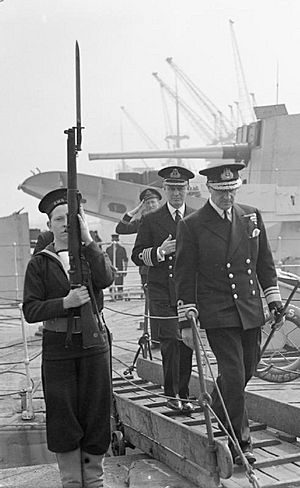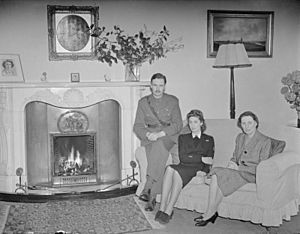William Whitworth (Royal Navy officer) facts for kids
Quick facts for kids
Sir William Whitworth
|
|
|---|---|

Vice Admiral Whitworth coming ashore after inspecting HMS Vanessa at the port of Liverpool
|
|
| Born | 29 June 1884 Chatham, Kent |
| Died | 25 October 1973 (aged 89) Bognor Regis, West Sussex |
| Allegiance | United Kingdom |
| Service/ |
Royal Navy |
| Years of service | 1899–1946 |
| Rank | Admiral |
| Commands held | Rosyth (1944–46) Second Sea Lord (1941–44) Battlecruiser Squadron (1939–41) HMS Rodney (1936) 2nd Destroyer Flotilla (1928–31) HMS Stuart (1928–31) HMS Valkyrie (1924–25) HMS Wryneck (1923–24) |
| Battles/wars | First World War Second World War |
| Awards | Knight Commander of the Order of the Bath Distinguished Service Order Mentioned in Despatches Order of St. Olav (Norway) |
Sir William Jock Whitworth (born June 29, 1884 – died October 25, 1973) was an important officer in the Royal Navy. He became an Admiral and held a very senior position called Second Sea Lord and Chief of Naval Personnel from 1941 to 1944. This role meant he was in charge of all the people serving in the Navy.
Contents
William Whitworth started his career in the Royal Navy as a cadet in 1899. This was when he was just 15 years old! On January 15, 1901, he was sent to serve on the battleship HMS Ocean. This ship was part of the China Station, which was a naval base in China. At the time, there was a conflict called the Boxer Rebellion happening in China.
Serving in World War I
Whitworth played a part in the First World War. During this war, he was in charge of several destroyer ships. These included HMS Cockatrice, HMS Orestes, and HMS Vidette. After the war, in 1926, he became the commanding officer at a special school in Portsmouth. This school taught physical and recreational training to naval personnel.
In 1928, he was given command of HMS Stuart. He also led the 2nd Destroyer Flotilla, which was a group of destroyers, in the Mediterranean Fleet.
Important Roles Before World War II
By 1933, Whitworth was appointed Captain of the Fleet. This meant he was a chief assistant to the Commander-in-Chief of the Mediterranean Fleet. In 1936, he took command of the powerful battleship HMS Rodney. A year later, in 1937, he became the Naval Secretary. This was an important job that involved managing naval affairs.
Leading in World War II
Whitworth served bravely in the Second World War. In 1939, he was given command of the Battlecruiser Squadron, a group of very strong warships.
Battles in Norway
He took part in the Norwegian Campaign in 1940. This was a series of battles fought in Norway. With his flag flying on the battleship HMS Warspite, he led the Royal Navy to an important victory. This happened at the second Battle of Narvik off the coast of Norway. After this success, he returned to lead the Battlecruiser Squadron later in 1940.
In 1941, Whitworth was promoted to Second Sea Lord and Chief of Naval Personnel. This was a very high-ranking job where he was responsible for all the sailors and officers in the Royal Navy. In 1944, he became the Commander-in-Chief, Rosyth. He retired from the Navy in 1946 after a long and distinguished career.
Family Life
In 1910, William Whitworth married Marguerite MacLean.


